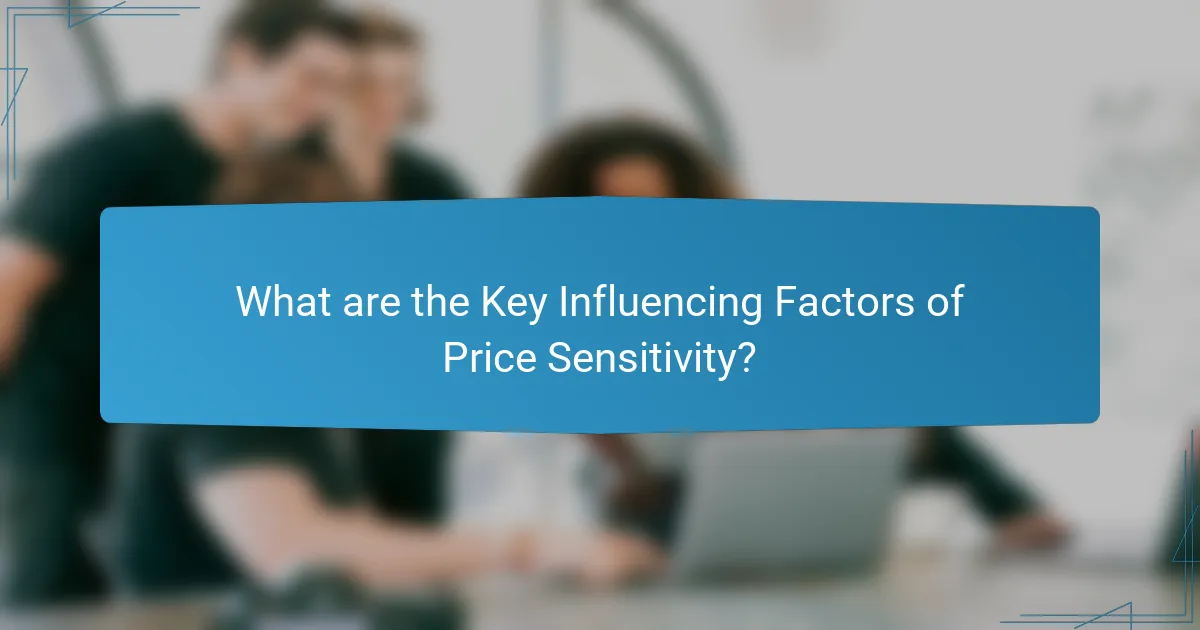Price sensitivity among consumers is the extent to which price fluctuations influence their purchasing behavior. This article examines the key factors affecting price sensitivity, including consumer income, perceived value, and the availability of substitutes. It highlights that higher income generally reduces price sensitivity, while strong perceived value and numerous alternatives can increase it. Understanding these dynamics is essential for businesses to develop effective pricing strategies, as they directly impact demand and revenue. The analysis also discusses market implications, such as how businesses can leverage price sensitivity insights for promotional strategies and inventory management.

What is Price Sensitivity Among Consumers?
Price sensitivity among consumers refers to the degree to which the price of a product affects their purchasing behavior. It indicates how changes in price can influence demand for a product or service. High price sensitivity means consumers are likely to reduce their purchases if prices increase. Conversely, low price sensitivity suggests that consumers will continue to buy despite price changes. Factors influencing price sensitivity include consumer income, availability of substitutes, and perceived value. Research shows that 70% of consumers consider price a significant factor in their purchasing decisions. Understanding price sensitivity helps businesses set optimal pricing strategies.
How is price sensitivity defined in consumer behavior?
Price sensitivity in consumer behavior is defined as the degree to which the price of a product affects consumers’ purchasing decisions. Consumers with high price sensitivity are more likely to change their buying habits in response to price changes. This behavior is influenced by factors such as income levels, perceived value, and availability of substitutes. Research indicates that about 60% of consumers consider price as a primary factor in their purchasing decisions. Price sensitivity can vary across different product categories and demographics. For example, essential goods often exhibit lower price sensitivity compared to luxury items. Understanding price sensitivity helps businesses optimize pricing strategies and improve sales outcomes.
What factors contribute to an individual’s price sensitivity?
An individual’s price sensitivity is influenced by multiple factors. Income level significantly affects how consumers perceive price changes. Higher income typically results in lower price sensitivity. Conversely, lower income increases sensitivity to price fluctuations.
Consumer preferences also play a crucial role. If a product is seen as a necessity, individuals may be less sensitive to price changes. Brand loyalty can decrease price sensitivity. Loyal customers often prioritize brand over cost.
Market conditions impact price sensitivity as well. In a competitive market, consumers tend to be more price-sensitive. Seasonal demand variations can also affect sensitivity. During peak seasons, consumers may exhibit higher price tolerance.
Lastly, perceived value is essential. If consumers believe a product offers high value, they may be less sensitive to price. Research shows that perceived quality influences willingness to pay. Overall, these factors collectively shape an individual’s price sensitivity.
How does price sensitivity vary across different demographics?
Price sensitivity varies significantly across different demographics. Younger consumers tend to be more price-sensitive due to lower disposable incomes. In contrast, older consumers often have more financial stability, leading to less sensitivity. Income level also plays a crucial role; lower-income individuals prioritize price over brand loyalty. Geographic location affects price sensitivity as well; urban dwellers may exhibit different behaviors compared to rural consumers. Studies show that cultural factors can influence price sensitivity, with collectivist societies often placing greater emphasis on value. Gender differences are also evident, with women generally being more price-sensitive than men in certain markets. Overall, these demographic factors create a complex landscape of price sensitivity among consumers.
Why is understanding price sensitivity important for businesses?
Understanding price sensitivity is crucial for businesses because it directly influences pricing strategies. Price sensitivity determines how consumers react to price changes. Businesses can optimize revenue by identifying the right price points. Accurate understanding helps in segmenting customers based on their sensitivity. This segmentation allows for targeted marketing and promotions. Research indicates that a 1% decrease in price can lead to a 2% increase in demand for price-sensitive products. Moreover, knowing price sensitivity aids in forecasting sales and managing inventory effectively. Overall, it enhances competitive positioning in the market.
What impact does price sensitivity have on pricing strategies?
Price sensitivity significantly influences pricing strategies by determining how consumers react to price changes. High price sensitivity leads businesses to adopt competitive pricing to attract cost-conscious customers. Companies may implement discounts or promotions to capitalize on this sensitivity, ensuring sales volume remains robust. Conversely, low price sensitivity allows firms to set higher prices without losing customers. This enables premium pricing strategies, maximizing profit margins. Research indicates that 70% of consumers consider price as a primary factor in purchasing decisions. Understanding price sensitivity helps businesses tailor their strategies effectively to meet market demands.
How can businesses leverage price sensitivity insights for competitive advantage?
Businesses can leverage price sensitivity insights by adjusting pricing strategies to align with consumer expectations. Understanding how consumers react to price changes allows businesses to optimize their pricing models. For example, companies can implement dynamic pricing based on demand elasticity. This approach enables businesses to maximize revenue during peak demand periods. Additionally, offering targeted discounts can attract price-sensitive customers without eroding brand value. Research indicates that 70% of consumers consider price a key factor in purchasing decisions. By analyzing price sensitivity data, businesses can also segment their market more effectively. This segmentation allows for tailored marketing strategies that resonate with different consumer groups. Overall, leveraging price sensitivity insights can lead to increased sales and improved customer loyalty.

What are the Key Influencing Factors of Price Sensitivity?
Key influencing factors of price sensitivity include consumer income, perceived value, and availability of substitutes. Higher income generally decreases price sensitivity. Consumers with greater disposable income are less likely to be affected by price changes. Perceived value significantly impacts how consumers view product pricing. If consumers believe a product offers high value, they may be less sensitive to its price. The availability of substitutes also plays a crucial role. More alternatives increase price sensitivity, as consumers can easily switch if prices rise. Brand loyalty can reduce price sensitivity as well. Loyal customers may prioritize brand over price. Market conditions, such as economic trends and competition, further influence price sensitivity. In a competitive market, consumers are more likely to compare prices, increasing sensitivity.
How does perceived value influence price sensitivity?
Perceived value significantly influences price sensitivity among consumers. When consumers perceive high value in a product, they are less sensitive to price increases. This means they are willing to pay more, as they believe the benefits outweigh the costs. Conversely, if the perceived value is low, even small price increases may deter purchases. Research shows that consumers often base their purchasing decisions on the perceived quality and benefits of a product. For example, a study published in the Journal of Consumer Research found that perceived value directly correlates with consumers’ willingness to pay. This indicates that enhancing perceived value can mitigate price sensitivity effectively.
What role does brand loyalty play in price sensitivity?
Brand loyalty significantly reduces price sensitivity among consumers. Loyal customers are less likely to switch to competitors based on price alone. They perceive added value in their preferred brand, which leads to a willingness to pay higher prices. Research indicates that 60% of loyal customers will pay more for a brand they trust. This loyalty stems from positive experiences and emotional connections with the brand. Additionally, loyal customers are more likely to make repeat purchases, further insulating brands from price competition. Studies show that brands with high loyalty can maintain profitability even during price fluctuations.
How do economic conditions affect consumer price sensitivity?
Economic conditions significantly influence consumer price sensitivity. During economic downturns, consumers typically become more price-sensitive. They prioritize essential goods and seek discounts or lower-cost alternatives. Conversely, in a thriving economy, consumers may exhibit less price sensitivity. They often have higher disposable incomes and are willing to pay premium prices. Research shows that a 1% increase in unemployment can lead to a 0.5% increase in price sensitivity. This indicates that economic factors directly impact consumer purchasing behavior and willingness to pay.
What psychological factors influence price sensitivity?
Psychological factors influencing price sensitivity include perceived value, reference prices, and emotional responses. Perceived value refers to how consumers assess the worth of a product relative to its price. When consumers believe a product offers high value, they may be less sensitive to its price. Reference prices are the prices consumers expect based on past experiences or market comparisons. If the actual price exceeds the reference price, sensitivity increases. Emotional responses, such as fear of loss or desire for gain, also affect price sensitivity. For example, consumers may react more strongly to price increases than to price decreases due to loss aversion. Research indicates that these psychological factors significantly impact consumer behavior and purchasing decisions.
How does consumer perception of fairness impact price sensitivity?
Consumer perception of fairness significantly impacts price sensitivity. When consumers perceive prices as fair, they are less sensitive to price changes. Conversely, perceived unfair pricing can lead to increased price sensitivity. Research indicates that fairness perception is influenced by factors such as pricing transparency and perceived value. A study by Bolton et al. (2003) found that consumers are likely to react negatively to prices they deem unfair, making them more likely to seek alternatives. This illustrates that fairness perception directly correlates with consumer willingness to pay. Thus, businesses must ensure pricing strategies align with consumer expectations of fairness to maintain loyalty and minimize price sensitivity.
What is the relationship between emotional responses and price sensitivity?
Emotional responses significantly influence price sensitivity. When consumers experience positive emotions, they are more likely to overlook high prices. Conversely, negative emotions tend to increase price sensitivity, making consumers more price-conscious. Research shows that emotions can affect decision-making processes and perceived value. A study published in the Journal of Consumer Research found that emotional states can alter the importance of price in purchasing decisions. This indicates that marketers can leverage emotional appeals to influence consumer behavior regarding pricing.

What are the Market Implications of Price Sensitivity Analysis?
Price sensitivity analysis reveals how changes in price affect consumer purchasing behavior. Understanding price sensitivity helps businesses set optimal pricing strategies. High price sensitivity indicates that consumers may significantly reduce their purchases with small price increases. Conversely, low sensitivity suggests that consumers are less affected by price changes.
Market implications include the potential for revenue fluctuations based on pricing decisions. Companies can identify which products may benefit from price increases or require discounts. Additionally, it aids in segmenting the market based on consumer sensitivity. This analysis can inform promotional strategies and inventory management.
For example, a study by Nagle and Holden (2002) indicates that businesses can increase profitability by aligning prices with consumer sensitivity levels. Understanding these dynamics is crucial for effective pricing strategies and overall market competitiveness.
How can price sensitivity analysis inform product development?
Price sensitivity analysis can significantly inform product development by revealing how changes in price affect consumer demand. Understanding this relationship helps businesses optimize pricing strategies. It allows companies to identify the price points that maximize revenue without losing customers. Price sensitivity analysis also highlights consumer preferences and perceived value of a product. This data can guide feature enhancements and product variations. For instance, if consumers show high sensitivity to price increases, companies may focus on cost reduction or value addition. Historical data shows that brands that adapt their products based on price sensitivity often achieve better market performance. Therefore, integrating price sensitivity insights into product development can lead to more informed decisions and improved financial outcomes.
What strategies can companies adopt based on price sensitivity data?
Companies can adopt several strategies based on price sensitivity data. They can implement dynamic pricing to adjust prices based on consumer demand and competition. This strategy allows companies to maximize revenue during high demand and remain competitive during low demand.
Additionally, companies can segment their market based on price sensitivity levels. This approach enables tailored marketing and pricing strategies for different consumer groups. For example, price-sensitive consumers may respond well to discounts or promotions.
Moreover, companies can bundle products as a strategy to enhance perceived value. Bundling can attract price-sensitive customers who seek savings on multiple items.
Finally, companies can utilize psychological pricing techniques. Setting prices just below a whole number, such as $9.99 instead of $10, can influence consumer perception and buying behavior.
These strategies are supported by research indicating that understanding price sensitivity leads to improved pricing strategies and increased customer satisfaction.
What are the potential risks associated with misjudging price sensitivity?
Misjudging price sensitivity can lead to significant financial risks for businesses. Incorrect pricing strategies may result in lost sales if prices are set too high. This can alienate price-sensitive customers, leading to decreased market share. Conversely, pricing too low can erode profit margins and devalue the product. A study by McKinsey & Company found that companies that misjudge price sensitivity can see a 20% drop in revenue. Additionally, misjudging can lead to inventory issues, either excess stock or stockouts. Both scenarios can increase operational costs and reduce customer satisfaction. Accurate assessment of price sensitivity is crucial for maintaining competitive advantage.
How can businesses avoid common pitfalls in pricing decisions?
Businesses can avoid common pitfalls in pricing decisions by conducting thorough market research. Understanding consumer behavior is critical. Analyzing competitors’ pricing strategies helps identify positioning opportunities. Implementing value-based pricing aligns prices with perceived customer value. Regularly reviewing pricing strategies ensures they remain competitive and relevant. Utilizing pricing analytics can uncover insights into customer price sensitivity. Testing different pricing models can reveal optimal price points. These strategies are supported by research indicating that informed pricing decisions lead to increased profitability and market share.
What best practices should companies follow when analyzing price sensitivity?
Companies should employ a multifaceted approach when analyzing price sensitivity. First, they should conduct surveys to gather direct consumer feedback on pricing. This allows companies to understand perceived value and acceptable price ranges. Second, they should analyze historical sales data to identify trends related to price changes. This data reveals how past pricing strategies affected sales volume. Third, companies should implement A/B testing with different price points. This method provides real-time insights into consumer behavior. Fourth, they should segment their market to tailor pricing strategies for different demographics. This ensures that pricing aligns with varying consumer expectations. Lastly, companies should monitor competitors’ pricing strategies. This helps to contextualize their pricing within the market landscape. Collectively, these practices provide a comprehensive understanding of price sensitivity.
Price sensitivity among consumers is the degree to which price changes influence purchasing behavior, with high sensitivity leading to reduced purchases in response to price increases. This article explores key influencing factors such as consumer income, perceived value, and availability of substitutes, as well as the demographic variations in price sensitivity. It highlights the importance of understanding price sensitivity for businesses to optimize pricing strategies, enhance revenue, and inform product development. Additionally, the article discusses the risks associated with misjudging price sensitivity and provides best practices for analyzing consumer behavior effectively.